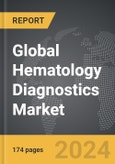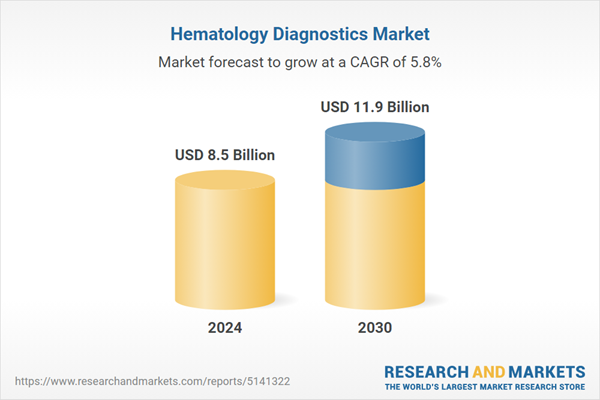The global market for Hematology Diagnostics was valued at US$8.5 Billion in 2024 and is projected to reach US$11.9 Billion by 2030, growing at a CAGR of 5.8% from 2024 to 2030. This comprehensive report provides an in-depth analysis of market trends, drivers, and forecasts, helping you make informed business decisions. The report includes the most recent global tariff developments and how they impact the Hematology Diagnostics market.
Segments: Product (Consumables, Instruments); Test Type (Blood Count, Platelet Function, Hemoglobin, Hematocrit); End-Use (Hospitals, Diagnostic Laboratories, Other End-Uses).
Geographic Regions/Countries: World; United States; Canada; Japan; China; Europe (France; Germany; Italy; United Kingdom; Spain; Russia; and Rest of Europe); Asia-Pacific (Australia; India; South Korea; and Rest of Asia-Pacific); Latin America (Argentina; Brazil; Mexico; and Rest of Latin America); Middle East (Iran; Israel; Saudi Arabia; United Arab Emirates; and Rest of Middle East); and Africa.
The analysts continuously track trade developments worldwide, drawing insights from leading global economists and over 200 industry and policy institutions, including think tanks, trade organizations, and national economic advisory bodies. This intelligence is integrated into forecasting models to provide timely, data-driven analysis of emerging risks and opportunities.
Global Hematology Diagnostics Market - Key Trends & Drivers Summarized
Why Are Hematology Diagnostics Essential in Modern Healthcare?
Hematology diagnostics are critical in diagnosing and monitoring blood-related diseases, including anemia, infections, and hematological malignancies like leukemia. These tests provide valuable insights into blood cell counts, coagulation status, and cellular morphology, aiding in disease detection and treatment monitoring. As healthcare systems prioritize early diagnosis and preventive care, hematology diagnostics are essential in identifying abnormalities early, allowing for timely intervention. The role of hematology in assessing general health and diagnosing serious conditions has made these diagnostics a mainstay in medical laboratories.How Are Technological Advancements Improving Diagnostic Accuracy?
Technological advancements in hematology diagnostics are enhancing test accuracy, speed, and automation. Automated analyzers now provide rapid, high-throughput results, reducing manual processes and minimizing human error. Innovations such as flow cytometry and digital imaging enable detailed cellular analysis, allowing for more precise diagnoses. Point-of-care hematology analyzers are also becoming popular, offering rapid results in outpatient settings and supporting timely clinical decisions. These advancements are making hematology diagnostics more accessible, efficient, and reliable, benefiting both patients and healthcare providers.Why Is the Demand for Point-of-Care Hematology Diagnostics Increasing?
The demand for point-of-care (POC) hematology diagnostics is growing as healthcare providers seek to deliver faster diagnoses and improve patient experience. POC hematology tests are ideal for settings outside traditional laboratories, such as clinics and emergency rooms, where quick results are essential for decision-making. Portable POC devices enable healthcare providers to perform tests closer to the patient, facilitating immediate care and reducing the need for multiple appointments. This trend aligns with the broader shift toward decentralized healthcare and patient-centric solutions, which prioritize accessibility and efficiency.What Drives the Growth of the Hematology Diagnostics Market?
The growth in the hematology diagnostics market is driven by increased demand for early disease detection, advancements in automated diagnostics, and the rising adoption of point-of-care testing. Early detection initiatives support demand for hematology tests as healthcare systems emphasize preventive care. Technological innovations are enhancing diagnostic accuracy and speed, making automated hematology systems essential in medical laboratories. Additionally, the growing popularity of POC diagnostics reflects a shift toward accessible, patient-centered care, further fueling market expansion as hematology diagnostics evolve to meet modern healthcare needs.Report Scope
The report analyzes the Hematology Diagnostics market, presented in terms of units. The analysis covers the key segments and geographic regions outlined below.Segments: Product (Consumables, Instruments); Test Type (Blood Count, Platelet Function, Hemoglobin, Hematocrit); End-Use (Hospitals, Diagnostic Laboratories, Other End-Uses).
Geographic Regions/Countries: World; United States; Canada; Japan; China; Europe (France; Germany; Italy; United Kingdom; Spain; Russia; and Rest of Europe); Asia-Pacific (Australia; India; South Korea; and Rest of Asia-Pacific); Latin America (Argentina; Brazil; Mexico; and Rest of Latin America); Middle East (Iran; Israel; Saudi Arabia; United Arab Emirates; and Rest of Middle East); and Africa.
Key Insights:
- Market Growth: Understand the significant growth trajectory of the Consumables segment, which is expected to reach US$7.8 Billion by 2030 with a CAGR of a 5.4%. The Instruments segment is also set to grow at 6.7% CAGR over the analysis period.
- Regional Analysis: Gain insights into the U.S. market, valued at $2.2 Billion in 2024, and China, forecasted to grow at an impressive 9.2% CAGR to reach $2.7 Billion by 2030. Discover growth trends in other key regions, including Japan, Canada, Germany, and the Asia-Pacific.
Why You Should Buy This Report:
- Detailed Market Analysis: Access a thorough analysis of the Global Hematology Diagnostics Market, covering all major geographic regions and market segments.
- Competitive Insights: Get an overview of the competitive landscape, including the market presence of major players across different geographies.
- Future Trends and Drivers: Understand the key trends and drivers shaping the future of the Global Hematology Diagnostics Market.
- Actionable Insights: Benefit from actionable insights that can help you identify new revenue opportunities and make strategic business decisions.
Key Questions Answered:
- How is the Global Hematology Diagnostics Market expected to evolve by 2030?
- What are the main drivers and restraints affecting the market?
- Which market segments will grow the most over the forecast period?
- How will market shares for different regions and segments change by 2030?
- Who are the leading players in the market, and what are their prospects?
Report Features:
- Comprehensive Market Data: Independent analysis of annual sales and market forecasts in US$ Million from 2024 to 2030.
- In-Depth Regional Analysis: Detailed insights into key markets, including the U.S., China, Japan, Canada, Europe, Asia-Pacific, Latin America, Middle East, and Africa.
- Company Profiles: Coverage of players such as Abbott Laboratories, Beckman Coulter, Inc., F. Hoffmann-La Roche AG, Mindray Medical International Ltd., Siemens Healthineers and more.
- Complimentary Updates: Receive free report updates for one year to keep you informed of the latest market developments.
Some of the 43 companies featured in this Hematology Diagnostics market report include:
- Abbott Laboratories
- Beckman Coulter, Inc.
- F. Hoffmann-La Roche AG
- Mindray Medical International Ltd.
- Siemens Healthineers
- Sysmex Corporation
Tariff Impact Analysis: Key Insights for 2025
Global tariff negotiations across 180+ countries are reshaping supply chains, costs, and competitiveness. This report reflects the latest developments as of April 2025 and incorporates forward-looking insights into the market outlook.The analysts continuously track trade developments worldwide, drawing insights from leading global economists and over 200 industry and policy institutions, including think tanks, trade organizations, and national economic advisory bodies. This intelligence is integrated into forecasting models to provide timely, data-driven analysis of emerging risks and opportunities.
What’s Included in This Edition:
- Tariff-adjusted market forecasts by region and segment
- Analysis of cost and supply chain implications by sourcing and trade exposure
- Strategic insights into geographic shifts
Buyers receive a free July 2025 update with:
- Finalized tariff impacts and new trade agreement effects
- Updated projections reflecting global sourcing and cost shifts
- Expanded country-specific coverage across the industry
Table of Contents
I. METHODOLOGYII. EXECUTIVE SUMMARY2. FOCUS ON SELECT PLAYERSIII. MARKET ANALYSISCANADAITALYSPAINRUSSIAREST OF EUROPESOUTH KOREAREST OF ASIA-PACIFICARGENTINABRAZILMEXICOREST OF LATIN AMERICAIRANISRAELSAUDI ARABIAUNITED ARAB EMIRATESREST OF MIDDLE EASTIV. COMPETITION
1. MARKET OVERVIEW
3. MARKET TRENDS & DRIVERS
4. GLOBAL MARKET PERSPECTIVE
UNITED STATES
JAPAN
CHINA
EUROPE
FRANCE
GERMANY
UNITED KINGDOM
ASIA-PACIFIC
AUSTRALIA
INDIA
LATIN AMERICA
MIDDLE EAST
AFRICA
Companies Mentioned (Partial List)
A selection of companies mentioned in this report includes, but is not limited to:
- Abbott Laboratories
- Beckman Coulter, Inc.
- F. Hoffmann-La Roche AG
- Mindray Medical International Ltd.
- Siemens Healthineers
- Sysmex Corporation
Table Information
| Report Attribute | Details |
|---|---|
| No. of Pages | 174 |
| Published | April 2025 |
| Forecast Period | 2024 - 2030 |
| Estimated Market Value ( USD | $ 8.5 Billion |
| Forecasted Market Value ( USD | $ 11.9 Billion |
| Compound Annual Growth Rate | 5.8% |
| Regions Covered | Global |









